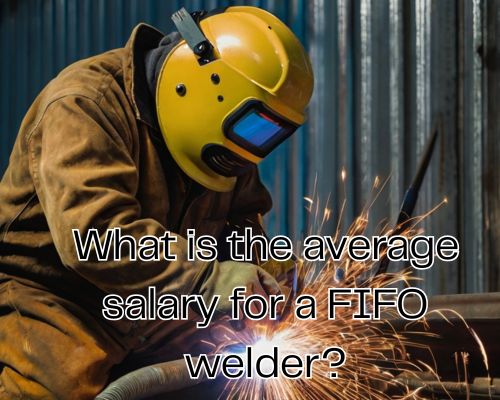When it comes to high-paying trades in Australia, few careers draw as much attention as FIFO (Fly-In Fly-Out) welding roles—particularly in Victoria, a state steadily growing its influence in the resources and infrastructure sectors. If you’ve ever wondered, “What is the average salary for a FIFO welder?”, ith Plumber Warragul, we’ll break it all down—pay rates, influencing factors, and what to expect if you’re considering this path in Victoria, Australia.

💼 What Is a FIFO Welder?
A FIFO welder is a tradesperson who is flown into a remote or regional work site (often mining, gas, or construction-related) for a fixed roster, then flown back home after their shift cycle ends. Unlike metro-based welding jobs, FIFO roles often involve intensive labour, long hours, and harsh environmental conditions—but they also come with premium pay and additional allowances.
In Victoria, FIFO roles are less prominent than in WA or Queensland, but they do exist—particularly in regional infrastructure builds, energy projects (like Loy Yang and Mortlake Power Station), and cross-state FIFO contracts connected to larger national companies.
💲 Average FIFO Welder Salary in Victoria
So, what is the average salary for a FIFO welder in Victoria, Australia?
While the salary varies based on the project, employer, and level of experience, FIFO welders in Victoria can expect to earn between $120,000 and $160,000 AUD annually. This includes base wages, overtime, site allowances, and additional incentives such as retention bonuses or travel reimbursements.
📊 Salary Snapshot:
| Experience Level | Average Annual Pay (AUD) |
|---|---|
| Entry-Level (0–2 yrs) | $100,000–$120,000 |
| Mid-Level (3–5 yrs) | $130,000–$150,000 |
| Senior Welder (5+ yrs) | $150,000–$170,000+ |
Pro Tip: Highly skilled welders with certifications in pressure welding, pipe welding, or ASME/AS/NZS standards often command salaries at the top end of the spectrum.
📍 FIFO Welding in Victoria: A Closer Look
While Victoria is not traditionally known for its FIFO culture, demand has risen due to several factors:
- Regional Rail Revival projects
- Solar and wind farm installations in Mildura and western Victoria
- Pipeline construction and water infrastructure upgrades
- Spillover roles from FIFO contracts in South Australia or Western Australia, where Victorian-based welders fly out to remote mine or gas sites
🛫 Some FIFO roles may involve flying out of Melbourne Tullamarine Airport to hubs like Karratha, Newman, or Port Augusta, depending on contract scope.
💡 Factors That Influence FIFO Welder Salaries
Let’s unpack the core elements that affect FIFO welder pay in Victoria and beyond:
1. Location of the Worksite
Welders working in extreme remote or high-risk locations typically receive higher compensation due to isolation allowances and hardship pay.
2. Roster Type
Common FIFO rosters include 2:1, 3:1, or even 4:2 (weeks on/off). The longer and more demanding the rotation, the higher the base and overtime pay.
3. Certification and Specialisation
Welders certified in:
- AS/NZS ISO 9606-1
- Pressure Vessel Welding
- Pipe Welding
- Stainless Steel TIG Welding
earn substantially more due to the complexity and safety-critical nature of their tasks.
4. Employer Type
Large contractors like UGL, Monadelphous, or Downer Group often offer higher salary packages and more comprehensive benefits than smaller subcontractors.
Visit Plumber Warragul for more.
🧾 Taxation and Living Considerations
FIFO welders in Victoria may earn impressive gross salaries, but it’s essential to factor in:
- PAYG tax rates
- Lack of remote area tax concessions (unless based in regions classified as “remote” by the ATO)
- Additional superannuation contributions (often 10.5% or higher)
- The cost of upskilling (i.e., paying for qualifications like Cert III in Engineering – Fabrication Trade)
Fortunately, many FIFO jobs include:
- Paid flights and accommodation
- Daily meal allowances or site-provided meals
- Access to gym/recreational facilities on-site
🚧 Is FIFO Welding a Good Career in Victoria?
For tradespeople who can handle isolation, irregular routines, and physically demanding conditions, FIFO welding can be a financially rewarding path. It’s particularly well-suited for:
- Young welders looking to build capital quickly
- Tradespeople saving for home ownership
- Skilled professionals aiming to transition into site supervision or project management
However, it’s important to consider mental health, family life disruption, and burnout risks—especially with compressed rosters.
🧠 Career Growth & Future Outlook
According to Jobs and Skills Australia and SEEK, demand for qualified welders across Australia—particularly those willing to work FIFO—is forecast to remain strong over the next 5 years.
Projects driving demand include:
- Renewable energy projects (solar farms, offshore wind)
- Heavy infrastructure builds under Victoria’s Big Build initiative
- Gas and pipeline expansions in central and eastern Australia
Additionally, robotics and automation are expected to change the landscape. Welders with dual skills in automated welding systems, robot programming, or non-destructive testing (NDT) will be especially in demand.
🔚 Final Thoughts
So, what is the average salary for a FIFO welder in Victoria, Australia? As of 2025, it’s comfortably between $120,000 and $160,000+, with ample room for growth depending on skill, certification, and worksite remoteness. While FIFO welding may not be a lifelong fit for everyone, it offers a solid route to financial stability, career development, and exciting work across some of Australia’s most critical infrastructure sectors.
If you’re ready to fly out and weld your way into the top income brackets of the trades world—Victoria’s FIFO opportunities might just be your launchpad.